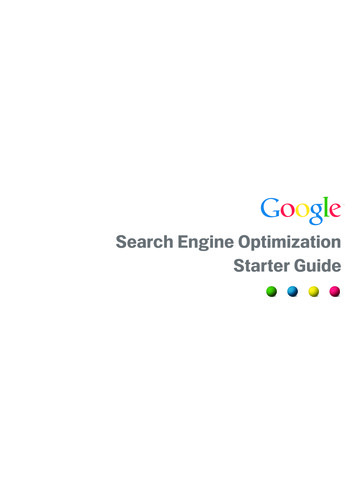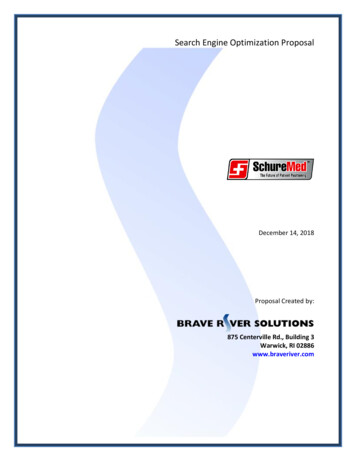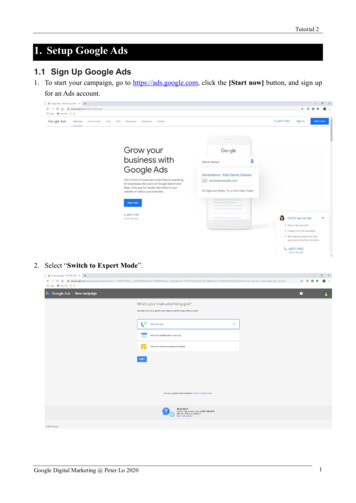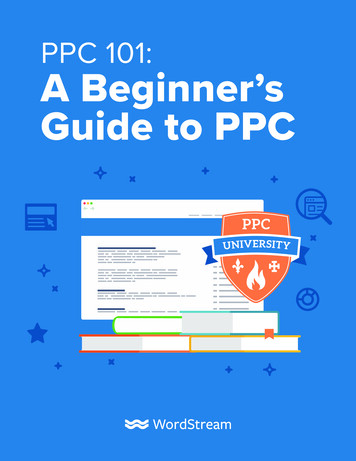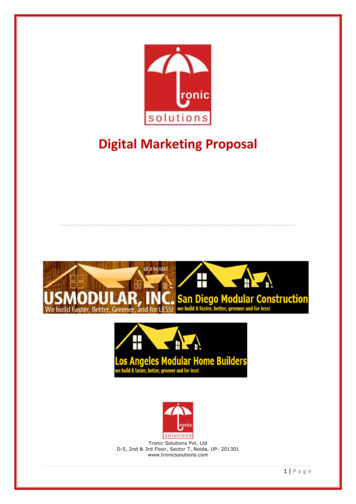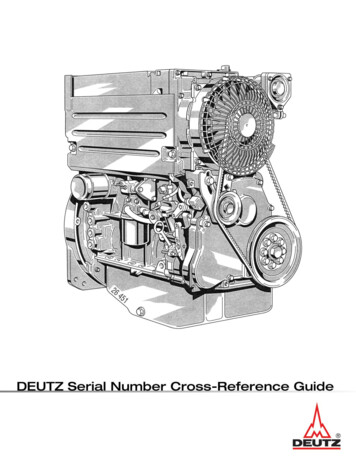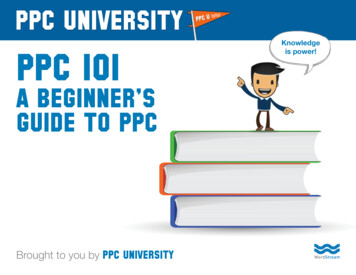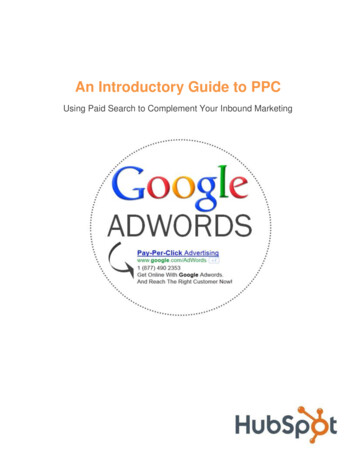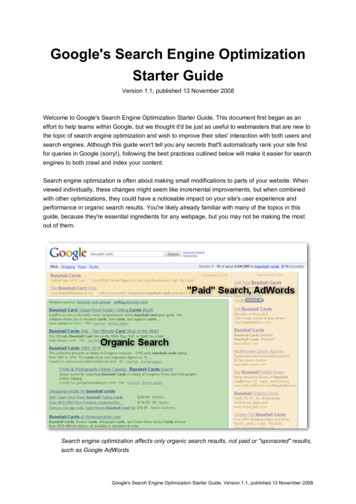
Transcription
Google's Search Engine OptimizationStarter GuideVersion 1.1, published 13 November 2008Welcome to Google's Search Engine Optimization Starter Guide. This document first began as aneffort to help teams within Google, but we thought it'd be just as useful to webmasters that are new tothe topic of search engine optimization and wish to improve their sites' interaction with both users andsearch engines. Although this guide won't tell you any secrets that'll automatically rank your site firstfor queries in Google (sorry!), following the best practices outlined below will make it easier for searchengines to both crawl and index your content.Search engine optimization is often about making small modifications to parts of your website. Whenviewed individually, these changes might seem like incremental improvements, but when combinedwith other optimizations, they could have a noticeable impact on your site's user experience andperformance in organic search results. You're likely already familiar with many of the topics in thisguide, because they're essential ingredients for any webpage, but you may not be making the mostout of them.Search engine optimization affects only organic search results, not paid or "sponsored" results,such as Google AdWordsGoogle's Search Engine Optimization Starter Guide, Version 1.1, published 13 November 2008
Even though this guide's title contains the words "search engine", we'd like to say that you shouldbase your optimization decisions first and foremost on what's best for the visitors of your site. They'rethe main consumers of your content and are using search engines to find your work. Focusing toohard on specific tweaks to gain ranking in the organic results of search engines may not deliver thedesired results. Search engine optimization is about putting your site's best foot forward when itcomes to visibility in search engines.An example may help our explanations, so we've created a fictitious website to follow throughout theguide. For each topic, we've fleshed out enough information about the site to illustrate the point beingcovered. Here's some background information about the site we'll use: Website/business name: "Brandon's Baseball Cards"Domain name: brandonsbaseballcards.comFocus: Online-only baseball card sales, price guides, articles, and news contentSize: Small, 250 pagesYour site may be smaller or larger than this and offer vastly different content, but the optimizationtopics we discussed below should apply to sites of all sizes and types.We hope our guide gives you some fresh ideas on how to improve your website, and we'd love tohear your questions, feedback, and success stories in the Google Webmaster Help Group.Create unique, accurate page titlesA title tag tells both users and search engines what the topic of a particular page is. The title tagshould be placed within the head tag of the HTML document. Ideally, you should create a uniquetitle for each page on your site.The title of the homepage for our baseball card site, which lists the business name and threemain focus areasGoogle's Search Engine Optimization Starter Guide, Version 1.1, published 13 November 2008
If your document appears in a search results page, the contents of the title tag will usually appear inthe first line of the results (If you're unfamiliar with the different parts of a Google search result, youmight want to check out the anatomy of a search result video by Google engineer Matt Cutts, and thishelpful diagram of a Google search results page.) Words in the title are bolded if they appear in theuser's search query. This can help users recognize if the page is likely to be relevant to their search.The title for your homepage can list the name of your website/business and could include other bits ofimportant information like the physical location of the business or maybe a few of its main focuses orofferings.A user performs the query [baseball cards]Our homepage shows up as a result, with the title listed on the first line (notice that the queryterms the user searched for appear in bold)If the user clicks the result and visits the page, the page's title will appear at the top of thebrowserTitles for deeper pages on your site should accurately describe the focus of that particular page andalso might include your site or business name.A user performs the query [rarest baseball cards]Google's Search Engine Optimization Starter Guide, Version 1.1, published 13 November 2008
A relevant, deeper page (its title is unique to the content of the page) on our site appears as aresultGood practices for page title tags Accurately describe the page's content - Choose a title that effectively communicates thetopic of the page's content.Avoid: choosing a title that has no relation to the content on the page using default or vague titles like "Untitled" or "New Page 1" Create unique title tags for each page - Each of your pages should ideally have a uniquetitle tag, which helps Google know how the page is distinct from the others on your site.Avoid: using a single title tag across all of your site's pages or a large group of pages Use brief, but descriptive titles - Titles can be both short and informative. If the title is toolong, Google will show only a portion of it in the search result.Avoid: using extremely lengthy titles that are unhelpful to users stuffing unneeded keywords in your title tagsMake use of the "description" meta tagA page's description meta tag gives Google and other search engines a summary of what the page isabout. Whereas a page's title may be a few words or a phrase, a page's description meta tag mightbe a sentence or two or a short paragraph. Google Webmaster Tools provides a handy contentanalysis section that'll tell you about any description meta tags that are either too short, long, orduplicated too many times (the same information is also shown for title tags). Like the title tag,the description meta tag is placed within the head tag of your HTML document.Google's Search Engine Optimization Starter Guide, Version 1.1, published 13 November 2008
The beginning of the description meta tag for our homepage, which gives a brief overview ofthe site's offeringsDescription meta tags are important because Google might use them as snippets for your pages.Note that we say "might" because Google may choose to use a relevant section of your page's visibletext if it does a good job of matching up with a user's query. Alternatively, Google might use your site'sdescription in the Open Directory Project if your site is listed there (learn how to prevent searchengines from displaying ODP data). Adding description meta tags to each of your pages is always agood practice in case Google cannot find a good selection of text to use in the snippet. TheWebmaster Central Blog has an informative post on improving snippets with better description metatags.Snippets appear under a page's title and above a page's URL in a search result.A user performs the query [baseball cards]Our homepage appears as a result, with part of its description meta tag used as the snippetWords in the snippet are bolded when they appear in the user's query. This gives the user clues aboutwhether the content on the page matches with what he or she is looking for. Below is anotherexample, this time showing a snippet from a description meta tag on a deeper page (which ideally hasits own unique description meta tag) containing an article.Google's Search Engine Optimization Starter Guide, Version 1.1, published 13 November 2008
A user performs the query [rarest baseball cards]One of our deeper pages, with its unique description meta tag used as the snippet, appears asa resultGood practices for description meta tags Accurately summarize the page's content - Write a description that would both inform andinterest users if they saw your description meta tag as a snippet in a search result.Avoid: writing a description meta tag that has no relation to the content on the page using generic descriptions like "This is a webpage" or "Page about baseballcards" filling the description with only keywords copy and pasting the entire content of the document into the description metatag Use unique descriptions for each page - Having a different description meta tag for eachpage helps both users and Google, especially in searches where users may bring upmultiple pages on your domain (e.g. searches using the site: operator). If your site hasthousands or even millions of pages, hand-crafting description meta tags probably isn'tfeasible. In this case, you could automatically generate description meta tags based oneach page's content.Avoid: using a single description meta tag across all of your site's pages or a largegroup of pagesImprove the structure of your URLsCreating descriptive categories and filenames for the documents on your website can not only helpyou keep your site better organized, but it could also lead to better crawling of your documents byGoogle's Search Engine Optimization Starter Guide, Version 1.1, published 13 November 2008
search engines. Also, it can create easier, "friendlier" URLs for those that want to link to your content.Visitors may be intimidated by extremely long and cryptic URLs that contain few recognizable words.A URL to a page on our baseball card site that a user might have a hard time withURLs like these can be confusing and unfriendly. Users would have a hard time reciting the URL frommemory or creating a link to it. Also, users may believe that a portion of the URL is unnecessary,especially if the URL shows many unrecognizable parameters. They might leave off a part, breakingthe link.Some users might link to your page using the URL of that page as the anchor text. If your URLcontains relevant words, this provides users and search engines with more information about thepage than an ID or oddly named parameter would.The highlighted words above could inform a user or search engine what the target page isabout before following the linkLastly, remember that the URL to a document is displayed as part of a search result in Google, belowthe document's title and snippet. Like the title and snippet, words in the URL on the search resultappear in bold if they appear in the user's query.A user performs the query [baseball cards]Our homepage appears as a result, with the URL listed under the title and snippetGoogle's Search Engine Optimization Starter Guide, Version 1.1, published 13 November 2008
Below is another example showing a URL on our domain for a page containing an article about therarest baseball cards. The words in the URL might appeal to a search user more than an ID numberlike "www.brandonsbaseballcards.com/article/102125/" would.A user performs the query [rarest baseball cards]A deeper page, with a URL that reflects the type of content found on it, appears as a resultGoogle is good at crawling all types of URL structures, even if they're quite complex, but spending thetime to make your URLs as simple as possible for both users and search engines can help. Somewebmasters try to achieve this by rewriting their dynamic URLs to static ones; while Google is finewith this, we'd like to note that this is an advanced procedure and if done incorrectly, could causecrawling issues with your site. To learn even more about good URL structure, we recommend thisWebmaster Help Center page on creating Google-friendly URLs.Good practices for URL structure Use words in URLs - URLs with words that are relevant to your site's content and structureare friendlier for visitors navigating your site. Visitors remember them better and might bemore willing to link to them.Avoid: using lengthy URLs with unnecessary parameters and session IDs choosing generic page names like "page1.html" using excessive keywords like "baseball-cards-baseball-cards-baseballcards.htm" Create a simple directory structure - Use a directory structure that organizes your contentwell and is easy for visitors to know where they're at on your site. Try using your directorystructure to indicate the type of content found at that URL.Avoid: having deep nesting of subdirectories like "./dir1/dir2/dir3/dir4/dir5/dir6/page.html" using directory names that have no relation to the content in themGoogle's Search Engine Optimization Starter Guide, Version 1.1, published 13 November 2008
Provide one version of a URL to reach a document - To prevent users from linking to oneversion of a URL and others linking to a different version (this could split the reputation ofthat content between the URLs), focus on using and referring to one URL in the structureand internal linking of your pages. If you do find that people are accessing the same contentthrough multiple URLs, setting up a 301 redirect from non-preferred URLs to the dominantURL is a good solution for this.Avoid: having pages from subdomains and the root directory (e.g. "domain.com/page.htm" and "sub.domain.com/page.htm") access the same content mixing www. and non-www. versions of URLs in your internal linking structure using odd capitalization of URLs (many users expect lower-case URLs andremember them better)Make your site easier to navigateThe navigation of a website is important in helping visitors quickly find the content they want. It canalso help search engines understand what content the webmaster thinks is important. AlthoughGoogle's search results are provided at a page level, Google also likes to have a sense of what role apage plays in the bigger picture of the site.All sites have a home or "root" page, which is usually the most frequented page on the site and thestarting place of navigation for many visitors. Unless your site has only a handful of pages, you shouldthink about how visitors will go from a general page (your root page) to a page containing morespecific content. Do you have enough pages around a specific topic area that it would make sense tocreate a page describing these related pages (e.g. root page - related topic listing - specific topic)?Do you have hundreds of different products that need to be classified under multiple category andsubcategory pages?The directory structure for our small website on baseball cardsGoogle's Search Engine Optimization Starter Guide, Version 1.1, published 13 November 2008
A sitemap (lower-case) is a simple page on your site that displays the structure of your website, andusually consists of a hierarchical listing of the pages on your site. Visitors may visit this page if theyare having problems finding pages on your site. While search engines will also visit this page, gettinggood crawl coverage of the pages on your site, it's mainly aimed at human visitors.An XML Sitemap (upper-case) file, which you can submit through Google's Webmaster Tools, makesit easier for Google to discover the pages on your site. Using a Sitemap file is also one way (thoughnot guaranteed) to tell Google which version of a URL you'd prefer as the canonical one (e.g.http://brandonsbaseballcards.com/ or http://www.brandonsbaseballcards.com/; more on what's apreferred domain). Google helped create the open source Sitemap Generator script to help youcreate a Sitemap file for your site. To learn more about Sitemaps, the Webmaster Help Centerprovides a useful guide to Sitemap files.Good practices for site navigation Create a naturally flowing hierarchy - Make it as easy as possible for users to go fromgeneral content to the more specific content they want on your site. Add navigation pageswhen it makes sense and effectively work these into your internal link structure.Avoid: creating complex webs of navigation links, e.g. linking every page on your siteto every other page going overboard with slicing and dicing your content (it takes twenty clicks toget to deep content) Use mostly text for navigation - Controlling most of the navigation from page to page onyour site through text links makes it easier for search engines to crawl and understand yoursite. Many users also prefer this over other approaches, especially on some devices thatmight not handle Flash or JavaScript.Avoid: having a navigation based entirely on drop-down menus, images, oranimations (many, but not all, search engines can discover such links on a site,but if a user can reach all pages on a site via normal text links, this will improvethe accessibility of your site; more on how Google deals with non-text files) Use "breadcrumb" navigation - A breadcrumb is a row of internal links at the top or bottomof the page that allows visitors to quickly navigate back to a previous section or the rootpage. Many breadcrumbs have the most general page (usually the root page) as the first,left-most link and list the more specific sections out to the right.Breadcrumb links appearing on a deeper article page on our siteGoogle's Search Engine Optimization Starter Guide, Version 1.1, published 13 November 2008
Put an HTML sitemap page on your site, and use an XML Sitemap file - A simplesitemap page with links to all of the pages or the most important pages (if you havehundreds or thousands) on your site can be useful. Creating an XML Sitemap file for yoursite helps ensure that search engines discover the pages on your site.Avoid: letting your HTML sitemap page become out of date with broken links creating an HTML sitemap that simply lists pages without organizing them, forexample by subject Consider what happens when a user removes part of your URL - Some users mightnavigate your site in odd ways, and you should anticipate this. For example, instead of usingthe breadcrumb links on the page, a user might drop off a part of the URL in the hopes offinding more general content. He or she might be 2008/upcoming-baseball-card-shows.htm, butthen enter http://www.brandonsbaseballcards.com/news/2008/ into the browser's addressbar, believing that this will show all news from 2008. Is your site prepared to show content inthis situation or will it give the user a 404 ("page not found" error)? What about moving up adirectory level to http://www.brandonsbaseballcards.com/news/? Have a useful 404 page - Users will occasionally come to a page that doesn't exist on yoursite, either by following a broken link or typing in the wrong URL. Having a custom 404 pagethat kindly guides users back to a working page on your site can greatly improve a user'sexperience. Your 404 page should probably have a link back to your root page and couldalso provide links to popular or related content on your site. Google provides a 404 widgetthat you can embed in your 404 page to automatically populate it with many useful features.You can also use Google Webmaster Tools to find the sources of URLs causing "not found"errors.Avoid: allowing your 404 pages to be indexed in search engines (make sure that yourwebserver is configured to give a 404 HTTP status code when non-existentpages are requested) providing only a vague message like "Not found", "404", or no 404 page at all using a design for your 404 pages that isn't consistent with the rest of your siteOffer quality content and servicesCreating compelling and useful content will likely influence your website more than any of the otherfactors discussed here. Users know good content when they see it and will likely want to direct otherusers to it. This could be through blog posts, social media services, email, forums, or other means.Organic or word-of-mouth buzz is what helps build your site's reputation with both users and Google,and it rarely comes without quality content.Google's Search Engine Optimization Starter Guide, Version 1.1, published 13 November 2008
A blogger finds a piece of your content, likes it, and then references it in a blog postWhile the content you create could be on any topic imaginable, here are some recommended bestpractices:Good practices for content Write easy-to-read text - Users enjoy content that is well written and easy to follow.Avoid: writing sloppy text with many spelling and grammatical mistakes embedding text in images for textual content (users may want to copy andpaste the text and search engines can't read it) Stay organized around the topic - It's always beneficial to organize your content so thatvisitors have a good sense of where one content topic begins and another ends. Breakingyour content up into logical chunks or divisions helps users find the content they want faster.Avoid: dumping large amounts of text on varying topics onto a page withoutparagraph, subheading, or layout separation Use relevant language - Think about the words that a user might search for to find a pieceof your content. Users who know a lot about the topic might use different keywords in theirsearch queries than someone who is new to the topic. For example, a long-time baseball fanmight search for [nlcs], an acronym for the National League Championship Series, while anew fan might use a more general query like [baseball playoffs]. Anticipating thesedifferences in search behavior and accounting for them while writing your content (using agood mix of keyword phrases) could produce positive results. Google AdWords provides ahandy Keyword Tool that helps you discover new keyword variations and see theapproximate search volume for each keyword. Also, Google Webmaster Tools provides youwith the top search queries your site appears for and the ones that led the most users toyour site. Create fresh, unique content - New content will not only keep your existing visitor basecoming back, but also bring in new visitors.Avoid: rehashing (or even copying) existing content that will bring little extra value tousersGoogle's Search Engine Optimization Starter Guide, Version 1.1, published 13 November 2008
having duplicate or near-duplicate versions of your content across your site(more on duplicate content) Offer exclusive content or services - Consider creating a new, useful service that no othersite offers. You could also write an original piece of research, break an exciting news story,or leverage your unique user base. Other sites may lack the resources or expertise to dothese things. Create content primarily for your users, not search engines - Designing your site aroundyour visitors' needs while making sure your site is easily accessible to search enginesusually produces positive results.Avoid: inserting numerous unnecessary keywords aimed at search engines but areannoying or nonsensical to users having blocks of text like "frequent misspellings used to reach this page" thatadd little value for users deceptively hiding text from users, but displaying it to search enginesWrite better anchor textAnchor text is the clickable text that users will see as a result of a link, and is placed within the anchortag a href "." /a .This anchor text accurately describes the content on one of our article pagesThis text tells users and Google something about the page you're linking to. Links on your page maybe internal—pointing to other pages on your site—or external—leading to content on other sites. Ineither of these cases, the better your anchor text is, the easier it is for users to navigate and forGoogle to understand what the page you're linking to is about.Good practices for anchor text Choose descriptive text - The anchor text you use for a link should provide at least a basicidea of what the page linked to is about.Avoid: writing generic anchor text like "page", "article", or "click here" using text that is off-topic or has no relation to the content of the page linked to using the page's URL as the anchor text in most cases (although there arecertainly legitimate uses of this, such as promoting or referencing a newwebsite's address)Google's Search Engine Optimization Starter Guide, Version 1.1, published 13 November 2008
Write concise text - Aim for short but descriptive text—usually a few words or a shortphrase.Avoid: writing long anchor text, such as a lengthy sentence or short paragraph of text Format links so they're easy to spot - Make it easy for users to distinguish betweenregular text and the anchor text of your links. Your content becomes less useful if usersmiss the links or accidentally click them.Avoid: using CSS or text styling that make links look just like regular text Think about anchor text for internal links too - You may usually think about linking interms of pointing to outside websites, but paying more attention to the anchor text used forinternal links can help users and Google navigate your site better.Avoid: using excessively keyword-filled or lengthy anchor text just for search engines creating unnecessary links that don't help with the user's navigation of the siteUse heading tags appropriatelyHeading tags (not to be confused with the head HTML tag or HTTP headers) are used to presentstructure on the page to users. There are six sizes of heading tags, beginning with h1 , the mostimportant, and ending with h6 , the least important.On a page containing a news story, we might put the name of our site into an h1 tag and thetopic of the story into an h2 tagSince heading tags typically make text contained in them larger than normal text on the page, this is avisual cue to users that this text is important and could help them understand something about thetype of content underneath the heading text. Multiple heading sizes used in order create a hierarchicalstructure for your content, making it easier for users to navigate through your document.Google's Search Engine Optimization Starter Guide, Version 1.1, published 13 November 2008
Good practices for heading tags Imagine you're writing an outline - Similar to writing an outline for a large paper, put somethought into what the main points and sub-points of the content on the page will be anddecide where to use heading tags appropriately.Avoid: placing text in heading tags that wouldn't be helpful in defining the structure ofthe page using heading tags where other tags like em and strong may be moreappropriate erratically moving from one heading tag size to another Use headings sparingly across the page - Use heading tags where it makes sense. Toomany heading tags on a page can make it hard for users to scan the content and determinewhere one topic ends and another begins.Avoid: excessively using heading tags throughout the page putting all of the page's text into a heading tag using heading tags only for styling text and not presenting structureOptimize your use of imagesImages may seem like a straightforward component of your site, but you can optimize your use ofthem. All images can have a distinct filename and "alt" attribute, both of which you should takeadvantage of.The "alt" attribute allows you to specify alternative text for the image if it cannot be displayed for somereason.Our alt text here is a brief but accurate description of the imageWhy use this attribute? If a user is viewing your site on a browser that doesn't support images, or isusing alternative technologies, such as a screen reader, the contents of the alt attribute provideinformation about the picture.Google's Search Engine Optimization Starter Guide, Version 1.1, published 13 November 2008
Our image wasn't displayed to the user for some reason, but at least the alt text wasAnother reason is that if you're using an image as a link, the alt text for that image will be treatedsimilarly to the anchor text of a text link. However, we don't recommend using too many images forlinks in your site's navigation when text links could serve the same purpose. Lastly, optimizing yourimage filenames and alt text makes it easier for image search projects like Google Image Search tobetter understand your images.Good practices for images Use brief, but descriptive filenames and alt text - Like many of the other parts of the pagetargeted for optimization, filenames and alt text (for ASCII languages) are best when they'reshort, but descriptive.Avoid: using generic filenames like "image1.jpg", "pic.gif", "1.jpg" when possible(some sites with thousands of images might consider automating the naming ofimages) writing extremely lengthy filenames stuffing keywords into alt text or copying and pasting entire sentences Supply alt text when using images as links - If you do decide to use an image as a link,filling out its alt text helps Google understand more about the page you're linking to. Imaginethat you're writing anchor text for a text link.Avoid: writing excessively long alt text that would be considered spammy using only image links for your site's navigation Store images in a directory of their own - Instead of having image files spread out innumerous directories and subdirectories across your domain, consider consolidating yourimages into a single directory (e.g. brandonsbaseballcards.com/images/). This simplifies thepath to your images.Google's Search Engine Optimization Starter Guide, Version 1.1, published 13 November 2008
Use commonly supported filetypes - Most browsers support JPEG, GIF, PNG, and BMPimage formats. It's also a good idea to have the extension of your filename match with thefiletype.Make effective use of robots.txtA "robots.txt" file tells search engines whether they can access and therefore crawl parts of yoursite. This file, which must be named "robots.txt", is placed in the root directory of your site.The address of our robots.txt fileAll compliant search engine bots (denoted by the wildcard * symbol) shouldn't access andcrawl the content under /images/ or any URL whose path begins with /searchYou may not want certain pages of your site crawled because they might not be useful to users iffound in a search engine's search results. If you do want to prevent search engines from crawlingyour pages, Google Webmaster Tools has a friendly robots.txt generator to help you creat
such as Google AdWords Google's Search Engine Optimization Starter Guide, Version 1.1, published 13 November 2008. Even though this guide's title contains the words "search engine", we'd like to say that you should base your optimization decisions first and forem
